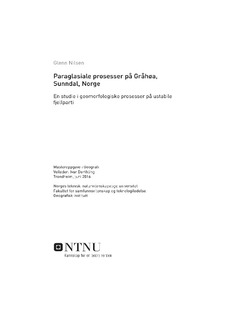Paraglasiale prosesser på Gråhøa, Sunndal, Norge : en studie i geomorfologiske prosesser på ustabile fjellparti
Master thesis
Permanent lenke
http://hdl.handle.net/11250/2449731Utgivelsesdato
2016Metadata
Vis full innførselSamlinger
- Institutt for geografi [1097]
Sammendrag
This study is looking at the paraglacial deformation of mountain slopes in deglaciated valleys in order to gain further insight into processes that lead to the development of these landforms. The research question is three fold: 1. Can a gravitational failure planes explain the present deformation and morphology at the site? 2. What earlier slope process are there? 3. Can earlier slope-, permafrost, freeze-thaw activity or glacial retreat processes explain deformation or present day morphology? An unexplained deformation and morphological expression on the plateau and northern slope on the mountain Gråhøa in Sunndal, Møre og Romsdal, Norway. Fieldwork conducted on the site in the period June 2015-October 2015. Several methods try to gain insight into the research question by combining them into one holistic approach. By using kinematic analysis on daylighting discontinuities from the unstable area to explore gravitational failure planes. Remote sensing data by InSAR measurements try to determine present day deformation at the study area. Statistical analysis on field temperature data to determine temperature regime at the site. A morphostratigraphic analysis on DEM. The results of these methods show that the present movement to be less than 2mm/y and discontinuities cannot explain the deformation and morphological expression at the site. The side is likely predisposed for permafrost at lower temperature regime during glacial periods. The morphostratigraphic data indicate that slope processes were probably most active during early Holocene and rates of rock wall retreat is at extreme maximum 881m3/y. The main result show the deformation and morphology at Gråhøa is consistent with paraglacial adjustment from the last ice age. Further research needed on the site in order to establish greater correlation to an example of a landform with paraglacial adjustment.
